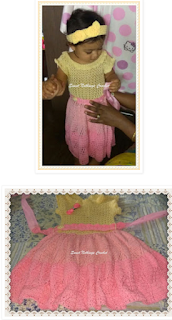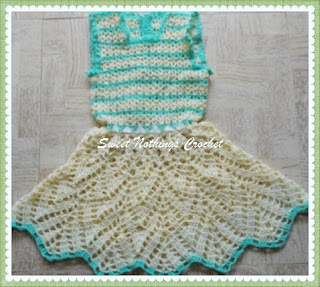Calculations : Yes this is always the foxing bit of our pattern – so here’s what I’ve done. I’ve worked one st in every dc, and then 3 sts in the ch-1 sps ; and 2 sts each in the corner ch-3 sps.
I then worked out how many pattern repeats I wanted for the body section, and accordingly worked out the number of stitches I’d need for the armhole section. Hope this works for you too.
The reason I am keeping this general is so that one can work any sized dress using this one general pattern.
Right then, once done with that, we’ll carry on with the body of our dress
PART 2 : BODY / SKIRT PORTION OF DRESS :
In the chart below, the first round has 192 sts, and then to add body, the designer has added 48 more to make it 240 sts.
I feel our first addition of 3 sts per ch-1 sp will give us a full enough body, and am working the pattern now according this, without further increases.
Round 1 : dc in the 1st 3 dc ;
*ch 3, sk next dc, sc in the next dc ;
ch 2, sk next dc, sc in the next dc ;
ch 3, sk next dc, dc in the next 3 dc* ;
rep *to* all around (including in the ch-section under armhole)
and join with sl-st to the 1st st.
Round 2 : 2 dc in the 1st dc ;
dc in the next dc ; 2 dc in the next dc ;
*ch 3 , sk ch-3 sp, sc in the next ch-2 sp ;
ch 3, sk next ch-3 sp, (2 dc in the next dc ;
dc in the next dc ; 2 dc in the next dc)* ;
rep *to* all around
and join with sl-st to the 1st st.
Round 3 : dc in the 1st 3 dc ;
*ch 5 , dc in the same 3rd dc (of that 5 dc set) and next 2 dc ;
sk both ch-sps and sc, dc in the next 3 dc* ;
rep *to* all around
and join with sl-st to the 1st st.
Round 4 : sc in the 1st dc ;
*ch 1 , sk next 2 dc, dc in the ch-5 sp ;
(ch 1, dc in the same ch-5 sp) ;
rep (to) 4 times ;
ch 1, sk next 2 dc, sc in the next 2 dc* ;
rep *to* all around
and join with sl-st to the 1st st.
dc 3-tog : Double crochet 3-tog : [yo, insert hk in st or ch-sp, yo and pull up a lp ; yo and draw through 2 lps] 3 times (4 lps on hk) ; yo, draw through all lps on hk. One dc 3-tog made.
Round 5 : sl-st into the 1st ch-1 sp ;
dc 3-tog in the same ch-1 sp ;
*(ch 2, dc 3-tog in the next ch-1 sp) ;
rep (to) 3 times ;
sk next 2 sc and ch-1 sp, dc-3 tog in the next ch-1 sp* ;
rep *to* all around
and join with sl-st to the 1st st.
Round 6 : sl-st into the 1st ch-2 sp ;
dc in the same ch-2 sp ;
*ch 2, sk next dc-3 tog, dc in the next ch-2 sp* ;
rep *to* all around
and join with sl-st to the 1st st.
Round 7 : dc in the 1st dc ;
*2 dc in the next ch-2 sp ; dc in the next dc* ;
rep *to* all around
and join with sl-st to the 1st st.
Round 8 : sc in the 1st dc ;
*ch 3, sk next 3 dc ; sc in the next 2 dc ;
ch 3, sk next 3 dc , sc in the next dc* ;
rep *to* all around
and join with sl-st to the 1st st.
Round 9 : sc in the 1st ch-3 sp ;
ch 3, sc in the same ch-3 sp ;
*ch 3, sk next 2 sc ; 3 dc in the next ch-3 sp ;
ch 3, sk next sc , sc in the next ch-3 sp ; ch 3, sc in the same ch-3 sp* ;
rep *to* all around
and for that last ch 3, join with dc to the 1st st.
This ensures that you are just where you need to be.
In case you find this too hard, please work ch 3 and join to the last st.
Then you will need to sl-st to get to where you need to be.
Round 10 : 2 dc in the 1st ch-sp ;
ch 3, sc in the same ch-3 sp ;
*ch 3, sc in the next ch-3 sp ;
ch 3, ( 2 dc in the next dc ; dc in the next dc ; 2 dc in the next dc)* ;
rep *to* all around till the last dc-set ;
2 dc in the next dc ;
dc in the last dc
and join with a sl-st to the 1st st.
Round 11 : dc in the 1st 2 dc ;
*sk both ch-sps and sc, dc in the next 3 dc ;
ch 5 , dc in the same 3rd dc (of that 5 dc set) and next 2 dc * ;
rep *to* all around till last dc-set ;
dc in the next 3 dc ;
ch 5 , dc in the same 3rd dc (of that 5 dc set) and next dc
and join with sl-st to the 1st st.
Round 12 : sl-st in the 1st dc ; sc in the next 2 dc ;
*ch 1 , sk next 2 dc, dc in the ch-5 sp ;
(ch 1, dc in the same ch-5 sp) ;
rep (to) 4 times ;
ch 1, sk next 2 dc, sc in the next 2 dc* ;
rep *to* all around
and join with sl-st to the 1st st.
Round 13 : sl-st into the 1st ch-1 sp ; dc 3-tog in the same ch-1 sp ;
*(ch 2, dc 3-tog in the next ch-1 sp) ;
rep (to) 3 times ;
sk next 2 sc and ch-1 sp, dc-3 tog in the next ch-1 sp* ;
rep *to* all around
and join with sl-st to the 1st st.
Using rep Rounds 6 – 13 as basic idea, work till you get the dress length you wish. There will be minor changes in where you start the round, but as we’ve worked 13 rounds, you’ll know.
Of course, you also have the chart below to follow up with.

















































Thanks for the pattern
ReplyDelete